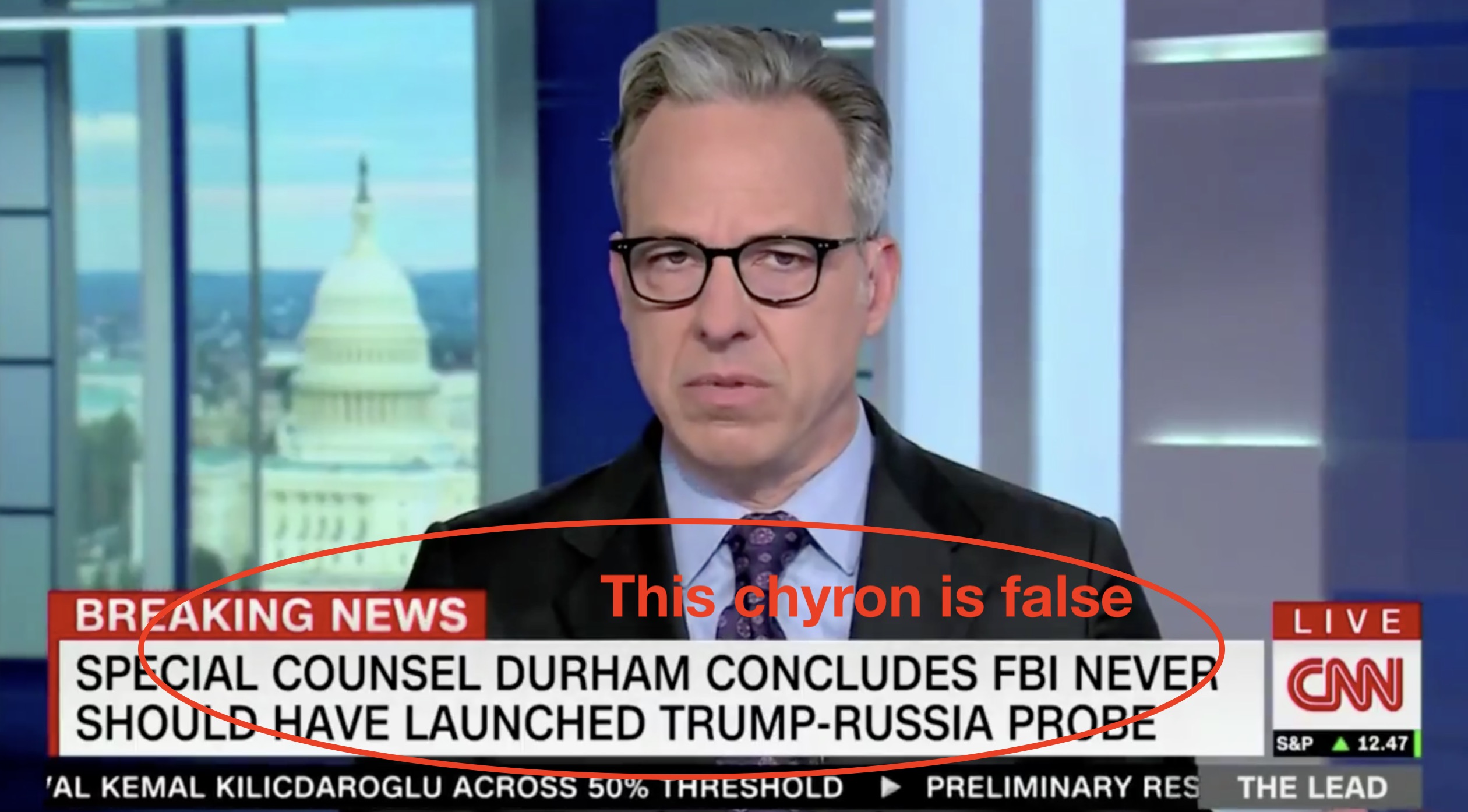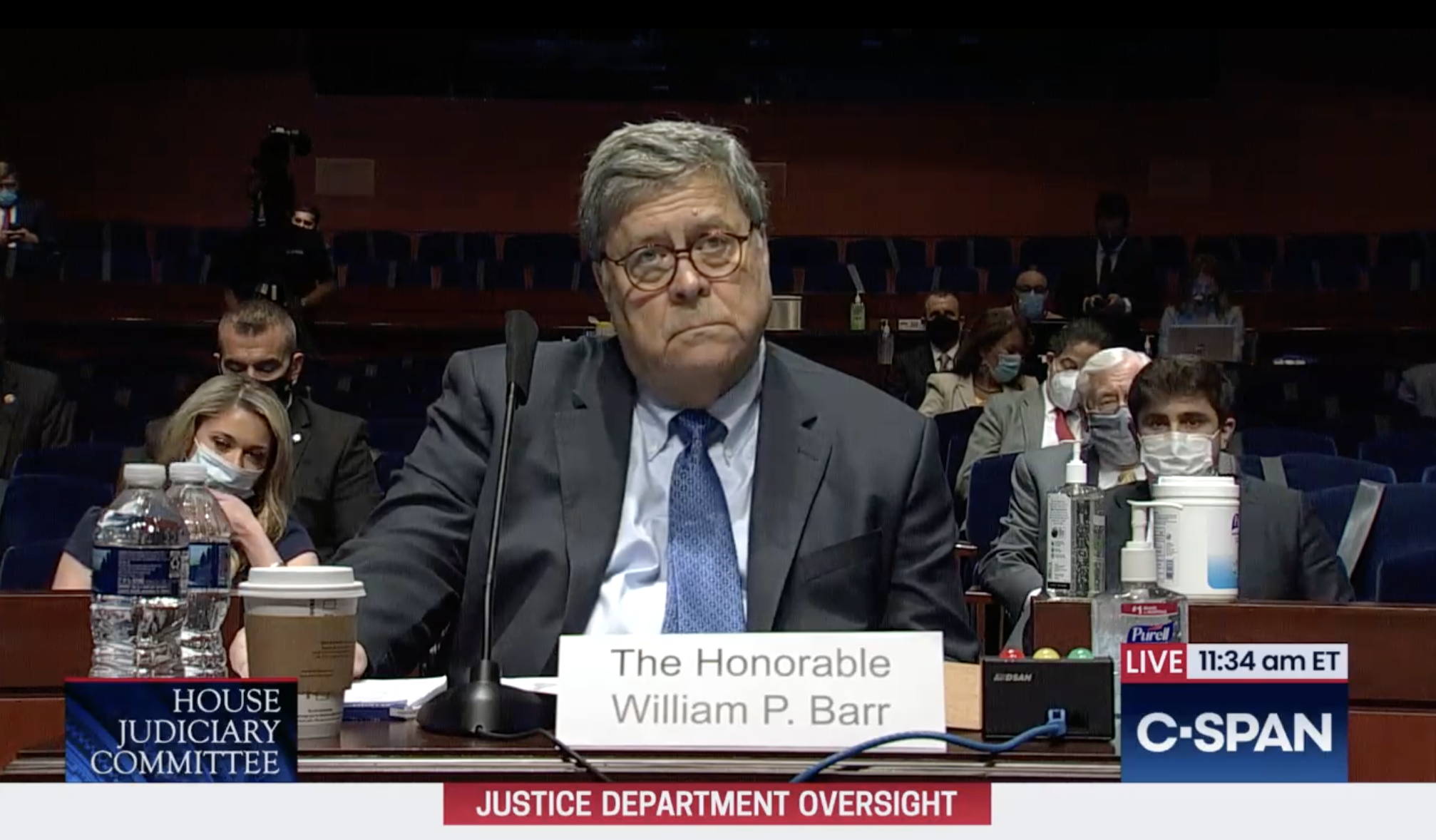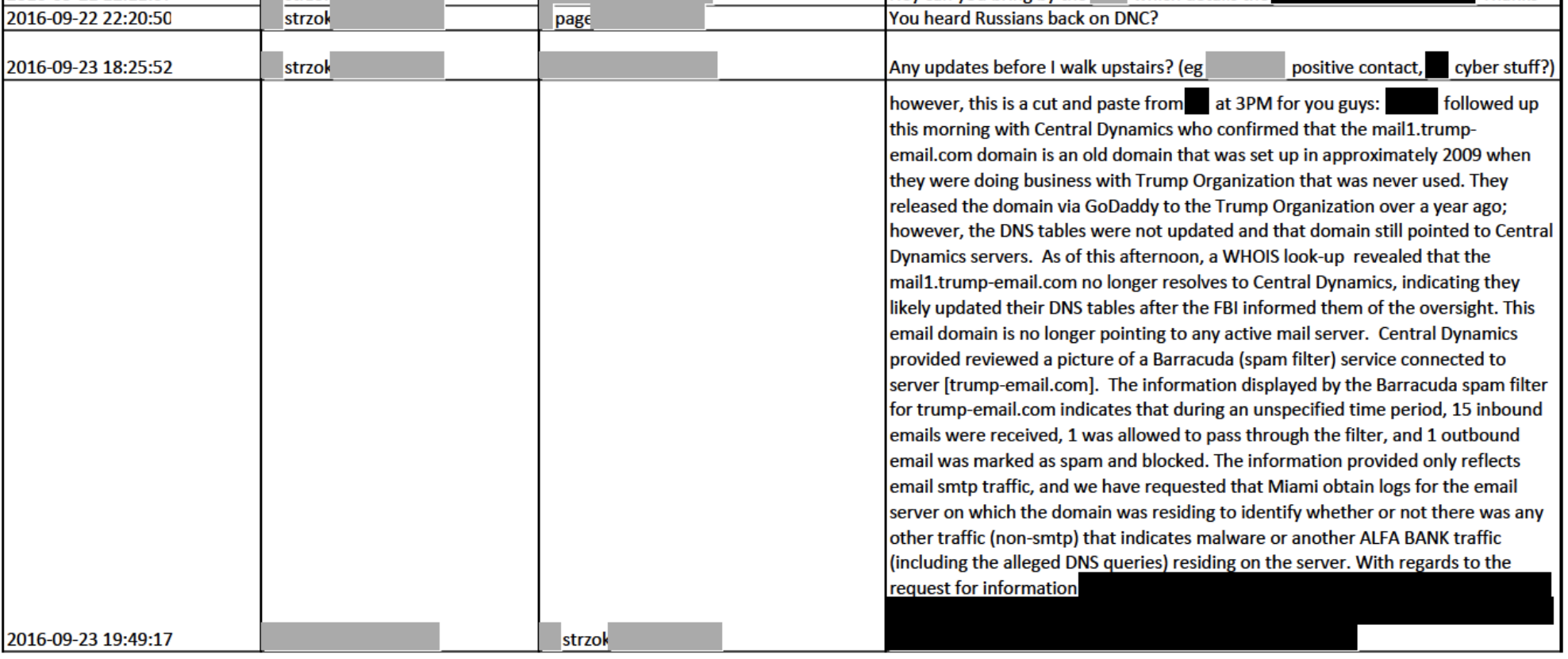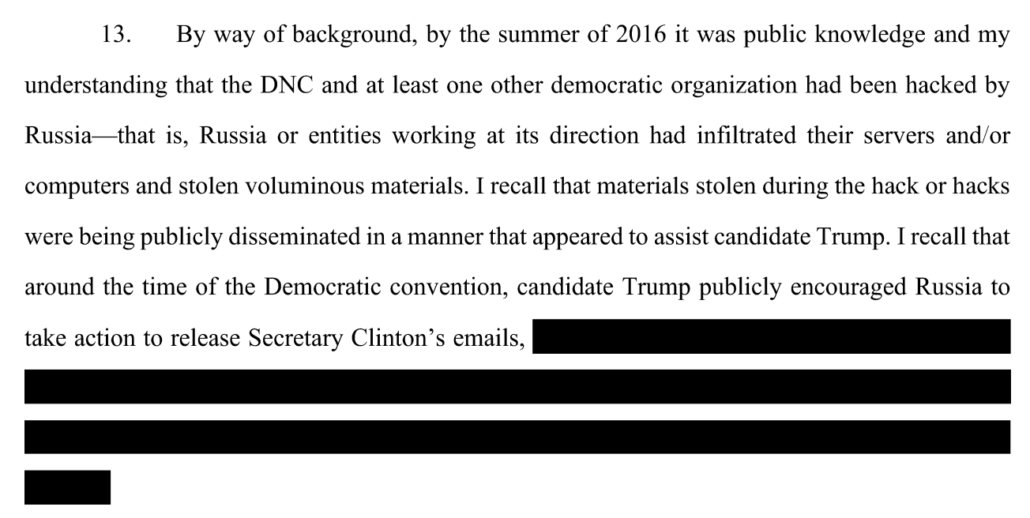I want to look at how CNN became a willing dupe of John Durham’s propaganda (and not for the first time, either).
An isolated clip of Jake Tapper, claiming the Durham Report “exonerates Trump” has gone viral. In much the same way that short clips of Kaitlan Collins’ Trump Town Hall have made the propaganda impact of that event even worse than the event itself, that clip has served as the equivalent of Bill Barr’s false claims about the Mueller Report, a premature and grossly inaccurate conclusion that served to pre-empt a more nuanced understanding of a deep reading of the report itself.
The clip came the day of the release of the report, seemingly before even a team of seven people could (and it’s clear, had) digested the full report, and to that extent, it made grand conclusions without understanding how the report itself totally undermines those conclusions. It closely parallels (though except for Tapper’s comment about exonerating Trump, is not even as bad as) an affirmatively problematic story that made the following misleading or affirmatively false claims:
- Special counsel John Durham concluded that the FBI should never have launched a full investigation into connections between Donald Trump’s campaign and Russia during the 2016 election, according to a report compiled over three years by the Trump-administration appointee and released on Monday.
- Durham’s 300-plus page report also states that the FBI used “raw, unanalyzed, and uncorroborated intelligence,” to launch the “Crossfire Hurricane” investigation into Trump and Russia but used a different standard when weighing concerns about alleged election interference regarding Hillary Clinton’s campaign.
- Durham notes that the FBI did not open an investigation into a purported plan by foreign operatives to target the Clinton campaign but rather took other steps in response to those concerns, which included providing defensive briefings for the then-Democratic presidential nominee and her staff.
- Mueller found no evidence of a conspiracy between the Trump campaign and Russia, but investigators documented numerous contacts between Trump associates and Russians.
I’ll explain why each of these claims should be corrected. Before I do, I want to look at comments that Tapper and others made in the appearance from which the clip was taken: because they actually provided evidence that undermined Durham’s key claims and, with more substance, would demonstrate that Durham repeatedly engaged in exactly the kind of misconduct of which he accused the FBI.
These details are why CNN’s people surely believe their report was not as problematic as it has been treated. But it’s also precisely why CNN owes its viewers a follow-up that describes how Durham fails to meet the standard to which he held the FBI.
First, Tapper noted that the Senate Intelligence Committee Report, completed by a Committee led by Republicans, had concluded that FBI had ample cause for concern in 2016.
Rachel Cohen, who is a spokeswoman — communications director for Mark Warner who is the chairman of the Senate Select Committee on Intelligence, she notes — and this is important context — that the Senate intelligence committee spent 3- 1/2 years reviewing millions of documents and interviewing hundreds of witnesses, this is on Twitter, and concluded that the FBI had ample cause for concern in 2016.
She notes that the committee, the Senate intelligence committee at the time was led by Republicans. She’s referring to former North Carolina Senator Richard Burr.
Tapper then described some of those concerns: not just the June 9 Trump Tower meeting, but also Paul Manafort sharing polling information with Konstantin Kilimnik (the record actually shows he also briefed Kilimnik on the campaign’s strategy to win swing states).
It’s also true that there was a lot of smoke, right? I mean, there was that meeting between the Trump campaign, Kushner, Don Jr. and others, that whole thing about, if it’s what you say it is, I love it, especially later in the summer.
There is, you know, Manafort giving polling information to Konstantin Kilimnik. There is stuff as the Senate Intelligence Committee communications director points out that would raise alarms.
Finally, Sara Murray added another cause for concern: Trump’s public coziness with Putin.
MURRAY: Well, yeah. There’s also how sort of publicly cozy Donald Trump was when he talked about Putin, when he talked about Russia that sort of raised red flags for people throughout the campaign.
Tapper and Murray have, in raising Kilimnik and others, identified one of the gaping holes in Durham’s report (which I wrote about here): the way he minimized what the final results of the Mueller investigation were.
Durham mentioned the June 9 meeting. He did not mention Kilimnik’s name once. He mentioned Roger Stone only in suggesting that Fusion GPS had unfairly identified him as someone with potential ties to Russia, a suspicion utterly vindicated by the Mueller investigation. Durham mentioned Trump’s “Russia, are you listening” comment four times, including two references to people describing it as important background to the predication of the investigation, but he never once considers whether a presidential campaign asking a hostile foreign power for help is itself evidence of “collusion.” Durham did not mention that Michael Cohen had called the Kremlin during the campaign to chase a Trump Tower deal, something that Trump lied about publicly in the same presser where he made the “Russia are you listening” comment, and something Cohen lied about to Congress. Durham used an ellipsis to alter the meaning of a key passage of the Mueller Report (the kind of deceit for which Durham rightly prosecuted Kevin Clinesmith), then used a range of other dishonest tactics to hide the true results of the investigation into George Papadopoulos, where the investigation actually started.
Between them, Tapper and Murray identified one of the most fatal gaps in Durham’s report, one that completely undermines Durham’s complaint that there was insufficient predication to open the investigation because there was no evidence of “collusion” in Intelligence Community coffers at the time the FBI opened the investigation.
If the IC doesn’t know that the campaign manager on a presidential campaign has employed someone that — the investigation would ultimately conclude — was a Russian agent sharing information with several more Russian agents, is that proof that the FBI shouldn’t have investigated, or that the IC hadn’t investigated enough in previous years? If the President’s rat-fucker told people on the campaign he was in direct contact (per Rick Gates’ testimony) with a persona run by the GRU weeks before the GRU would release emails stolen from Hillary, is the FBI wrong for ultimately discovering that, or was the FBI instead remiss for not investigating that tie until almost a year after it first would have been identified?
And that’s why the way CNN headlines its reports is so problematic. The transcript itself uses a teaser that, “Special Counsel Durham Concludes FBI Never Should Have Launched Trump-Russia Probe.” The chyron erroneously claimed that Durham “conclude[d]” that the FBI should never have launched the investigation. The headline of the problematic report reads, “Special counsel John Durham concludes FBI never should have launched full Trump-Russia probe.” The lede of that report states that,
Special counsel John Durham concluded that the FBI should never have launched a full investigation into connections between Donald Trump’s campaign and Russia during the 2016 election, according to a report compiled over three years by the Trump-administration appointee and released on Monday.
All are misrepresentations of what the report said, which the problematic report doesn’t clarify until sixteen paragraphs later. As Perez explained on Tapper,
Durham says that he sees reason for the FBI to at least take a look at some of the initial tips that led to what became Crossfire Hurricane. He said the FBI had reason to investigate, at least preliminary. What he doesn’t see is the reason for a full-blown investigation according to this report.
Durham’s judgment about the level of investigation not only ignores evidence presented at both trials about these various decisions (effectively, leaving out exculpatory evidence just as the FBI left out exculpatory evidence in the Carter Page applications). But he also never weighs the balance between a Full Investigation, which would last long enough to get through the election, at which point the FBI could engage in overt steps, with opening a Preliminary Investigation that might close before such steps could be taken. Indeed, many of Durham’s recommendations, as well as his complaints about the slow speed at which FBI did obtain very damning information on Trump’s associates, don’t account to the degree to which the FBI successfully shielded Trump from the impact of the disclosure of the investigation during the campaign, something the FBI failed to do for two investigations into Hillary during the same period.
And that’s why another point that Perez made is important.
Jake, one of the interesting — one of the things that stood out to me, if you remember the former president kept saying he was going to find evidence of deep state spying. Well, there is a part here that talks about a confidential human source, essentially a spy, who was tasked with going to a Clinton campaign fund-raiser. Let me repeat that. A Clinton campaign fund-raiser because the FBI had gotten information that somebody was saying that perhaps a foreign government might be expecting some favors from a future Clinton presidency.
So there you have it. The FBI was spying on the Clinton campaign, according to John Durham’s report.
To be very clear: This is not a judgment Durham made. It’s Perez’s judgment, instead, that applies the standards that Bill Barr and Durham adopted to be able to claim that the FBI “spied on” Trump’s campaign to the claims laid out by Durham about his purported comparison of the investigations into Hillary with the investigation into Trump. This is Perez reading Durham’s allegations on their face rather than parroting Durham’s conclusions.
Perez doesn’t note that there was another instance of an informant targeting Hillary in the Clinton Foundation investigation, the handling agents for which (and at least one likely witness for Durham) were shown to be biased in the DOJ IG Investigation. That’s another detail that — I noted — Durham left out of his report. Durham suggests that people like Strzok were predisposed to open an investigation into Trump, but never acknowledges that at least two of the FBI Agents investigating Hillary (and one of the FBI Agents investigating Mike Flynn) expressed pro-Trump bias in their FBI texts.
The fact that Perez busted Durham for adopting a double standard for his claims about the Trump campaign as he does to the Hillary campaign — again, precisely one of the problems he identifies in the Crossfire Hurricane investigation — makes these two misstatements in the published CNN report all the more unfortunate.
Durham’s 300-plus page report also states that the FBI used “raw, unanalyzed, and uncorroborated intelligence,” to launch the “Crossfire Hurricane” investigation into Trump and Russia but used a different standard when weighing concerns about alleged election interference regarding Hillary Clinton’s campaign.
[snip]
Durham notes that the FBI did not open an investigation into a purported plan by foreign operatives to target the Clinton campaign but rather took other steps in response to those concerns, which included providing defensive briefings for the then-Democratic presidential nominee and her staff.
These descriptions appear to be muddled (again, this report was written in the day of the release of the report). They either confuse the several investigations into Hillary that Durham describes or don’t address the Clinton Foundation one.
As for the Clinton Foundation investigation, even ignoring Durham’s silence about biased Agents on that team, Durham acknowledged that one office at the FBI opened a preliminary investigation into Hillary based solely off Clinton Cash. Durham made absolutely no mention about the tie between that unsubstantiated report and Trump’s eventual campaign manager — again, Durham here commits precisely the professional lapse he accuses the FBI of on the Carter Page application, hiding a tie to the campaign. Even on top of that, though, his ultimate comparison has several problems.
As an initial matter, the NYFO and WFO investigations appear to have been opened as preliminary investigations due to the political sensitivity and their reliance on unvetted hearsay information (the Clinton Cash book) and CHS reporting. 388 By contrast, the Crossfire Hurricane investigation was immediately opened as a full investigation despite the fact that it was similarly predicated on unvetted hearsay information. Furthermore, while the Department appears to have had legitimate concerns about the Foundation investigation occurring so close to a presidential election, it does not appear that similar concerns were expressed by the Department or FBI regarding the Crossfire Hurricane investigation.
One of three investigations was opened as a Full Investigation based off a source report and unverified documentary claims; if that investigation was okay, then making Crossfire Hurricane a Full Investigation upon receipt of the Steele dossier, however problematic, would have adopted the same standard. Furthermore, in Durham’s comparisons, he always leaves out the fact there was undeniably a crime committed before the opening of Crossfire Hurricane, the hack against the DNC. The question was whether Trump’s associates had a tie to that undenied crime, not whether a crime had been committed. Yet, as Adam Goldman recently revealed, the FBI investigated Clinton Foundation for five years and never found a crime they could charge.
More importantly, it is rank nonsense for Durham to claim that the FBI didn’t have concerns about investigating Trump’s aides so close to an election with Crossfire Hurricane. The election is precisely why the FBI chose to use covert means like informants instead of sending out subpoenas. It is precisely why it was March before the FBI had obtained call records (using NSLs) on three of four subjects of the investigation. It is precisely why the FBI didn’t discover ties to Ivan Timofeev that George Papadopoulos hid during his early interviews with the FBI until later.
Many of Durham’s complaints in his report are that the FBI didn’t use overt means, like interviewing George Papadopoulos or obtaining his and Sergei Millian’s call records, during the election season, effectively a complaint that the FBI adhered to election season restrictions on investigative activity. That’s particularly notable given the NYT report that Durham tried — only to be thwarted by Nora Dannehy’s noisy resignation — to release a report during the pre-election time period. Durham basically complained that the FBI adhered to a rule he attempted to break.
As for the two foreign interference investigations that CNN seems to reference, the first was opened as a Full Investigation from the start, in late 2014. It’s unclear what the classified corroboration for this is, but as described by Durham, Hillary’s campaign explicitly rebuffed this offer.
Beginning in late 2014, before Clinton formally declared her presidential candidacy, the FBI learned from a well-placed CHS (“CHS-A”) that a foreign government (“Foreign Government-2”) was planning to send an individual (“Non-U.S. Person-I”) to contribute to Clinton’s anticipated presidential campaign, as a way to gain influence with Clinton should she win the presidency. 316 The FBI’s independent corroboration of this information is discussed in the Classified Appendix.
Upon receipt of this information and the predication it provided, Field Office-I sought to have one of two other better-positioned and higher-resourced field offices open a counterintelligence or public corruption investigation into these allegations, but Counterintelligence Division Executive Management directed Field Office-I to open a full counterintelligence investigation into the matter. 317
And Durham’s own report describes that it took 11 months before Hillary was briefed on this counterintelligence concern and Republicans got a defensive briefing over a month earlier than Hillary.
In line with the directive, the FBI ultimately provided defensive briefings to the officials or their representatives, though it took approximately 11 months from the receipt of the original allegations. 328
328 OSC Report(s) of Interview(s) of Field Office-1 Handling Agent-1 on April 23, 2020 and May 5, 2020; OSC Report of Interview of Headquarters Supervisory Special Agent-4 on May 28, 2020 at 5 – 7; OSC Report of Interview of David Archey on June 21, 2021 at 1 – 3 ( discussing the rationale for the debriefings regarding the threat from Foreign Govemment-2 and ECs documenting the September 1, 2015 briefing to a designated staffer on behalf of an elected official within the Republican party, and the October 15, 2015 defensive briefing Archey provided to Clinton’s personal attorneys).
Trump was briefed on the investigation into Mike Flynn in January 2017, six months after the opening of an investigation into his associates (and President Obama gave Trump a separate warning about Mike Flynn before that, in November).
So Durham’s complaint, effectively, is that Trump’s warnings came sooner than Hillary’s did, and he says that shows the FBI was biased against Trump! That’s confirmation bias, not evidence, yet another thing Durham accuses the FBI of while committing the same error.
There’s another problem with Durham’s complaint about the differential treatment of the defensive briefing (a concern that Durham chased after Chuck Grassley raised it, yet another case where Durham did — allowed Congress to influence an investigation — what he complained the FBI had done improperly with Crossfire Hurricane). The lead about the other country’s attempted influence campaign came from operatives of the country, not the campaign itself. The lead about the foreign influence into Hillary’s campaign was prospective, from someone outside the campaign; the lead from Papadopoulos was historical, from someone inside the campaign. That is, from the start, the FBI had reason to believe that Trump would accept help offered by Russia.
That, plus the results of the Mueller investigation, vindicate the logic behind the FBI delay on briefing Trump — that someone might have taken the Russians up on their offer. The Mueller investigation showed that:
- Don Jr gleefully accepted an offer of help
- Michael Cohen sought and received Dmitry Peskov’s assistance for a real estate deal during the campaign
- George Papadopoulos did obtain advance notice of Russia’s interference and pursued a back channel with Russia at least until July 2016
- On Manafort’s request, Stone did pursue advance access to the stolen Hillary emails (both Manafort and Gates testified Stone actually got advance notice of the Podesta drop, and Gates claimed to have gotten advance notice of the earlier DNC drop)
- In pursuit of millions in debt relief, Manafort provided Konstantin Kilimnik campaign briefing
With the exception of the June 9 meeting, these are all the results of the investigation that Durham omits, effectively more exculpatory evidence that he left out, yet another instance where Durham commits precisely the errors he complains about.
As Perez rightly noted, if you take what Durham describes about the other investigations rather than conclusions he draws off misrepresentations of those descriptions, it’s clear that the decisions the FBI took arose from different circumstances. In two cases at least — the use of biased informants and the delay in defense briefings — the facts actually show Hillary was treated worse than Trump. And that’s before you get into the leaks and Comey violations of FBI procedures the FBI made during the election season with Hillary.
That’s why it matters that, in its written report, CNN appears to go beyond even what Durham claims about this differential treatment. I don’t think Durham shows the FBI used a different standard when opening the investigation into election interference (though he does show they delayed a FISA application). Likewise, the evidence shows that the FBI did open an investigation into the foreign election interference, and then expanded it to cover a second country.
Although this information pertained to a foreign influence threat from a different country, the handling agent for CHS-A continued to work this threat under the existing counterintelligence case for the threat CHS-A reported regarding Foreign Government-2
If anything, the Durham report shows that the informant the FBI was running was permitted to engage in illegal activities with Hillary even after the campaign asked a foreigner not to come to a campaign event (this may be the incident Perez refers to).
CHS-A, however, did attend a fundraiser in January 2016, after providing same-day notice and receiving the approval of his FBI handling agent. 345 CHS-A reported in an email that Insider-1 “got cold feet” and was not going to attend, but the source file report indicates Insider-1 was told by a representative of Clinton not to attend. 346 When Insider- I decided not to attend, he/she asked CHS-A to deliver a message of support. CHS-A provided the draft message to the handling agent, who received same-day approval from FBI OGC for the CHS to deliver the message at the event scheduled for later that day. 347
However, without the knowledge or prior approval of the handling agent, CHS-A had made a $2700 campaign contribution (the maximum amount at the time for an individual contribution) prior to the event, which CHS-A indicated he/she “made on [his/her] [credit] card” on behalf of Insider-I. 348 If true, the campaign contribution on behalf of a foreign national would violate Title 52 USC Section 30121 (“Contributions and donations by foreign nationals”). However, despite CHS-A’s claim that the contribution was made in his/her personal name, the Federal Election Commission records reviewed did not reveal any contribution in CHS-A’s name. Rather, Commission records corroborate a contribution paid by a credit card in the name of a close associate (who was a U.S. person) of CHS-A. CHS-A also told the handling agent that “[t]hey [the campaign] were okay with it. […]yes they were fully aware from the start” ofthe contribution being made on behalf of a foreign interest and CHS-A offered to provide a copy of the credit card charges. 349 Despite this offer by CHS-A to provide a copy of the credit card charges, we did not find any indication that the handling agent asked for or otherwise secured a copy. [my emphasis]
This looks like a poorly handled FBI informant attempted to frame Hillary during the election year, yet Durham nevertheless concludes from that that the FBI was biased against Trump.
This larger discussion — including Tapper and Murray’s ready list of all the damning details that Mueller found — is why CNN continues to err when it makes this claim, which appears to be part of its boilerplate.
Mueller found no evidence of a conspiracy between the Trump campaign and Russia, but investigators documented numerous contacts between Trump associates and Russians.
Of course Mueller found some evidence of a conspiracy — Tapper laid out some of that himself in his piece. Trump’s campaign manager shared the campaign’s swing state strategy with someone involved in the interference operation, and did so with the expectation he might get paid out of it. Ultimately, Mueller referred evidence of a CFAA conspiracy between Russia and Stone to DC USAO for further investigation, and he laid out but didn’t charge Manafort with conspiracy for his August 2 meeting, more clarity on which seems to have taken years to develop. Manafort did, notably, plead guilty to conspiring with Kilimnik, ultimately deemed to be a Russian agent, for attempting to cover up their full ties to Russian-backed Ukrainians, an effort that started during the campaign (and included the son-in-law of an Alfa Bank founder, precisely one of the concerns raised by one of the Alfa Bank researchers).
Just in that one Tapper appearance, CNN has shown that it knows better than to make these claims. CNN has shown awareness of two of the numerous instances of which Durham failed precisely the standards he tried to criminalize with the FBI.
And that’s why this early report — a report just as toxic as Bill Barr’s more deliberate effort to misrepresent the results of an investigation — should be revisited. Particularly given that, as the problematic report and Murray’s appearance with Tapper make clear, Jim Jordan and others are going to use this as a political football.
If Jim Jordan wants to talk about the weaponization of government, Durham’s own failures should be the focus, not the claims he sustains only by violating precisely the standards he tried to criminally enforce.
Update: Corrected that the Tapper appearance was the day of the report.









